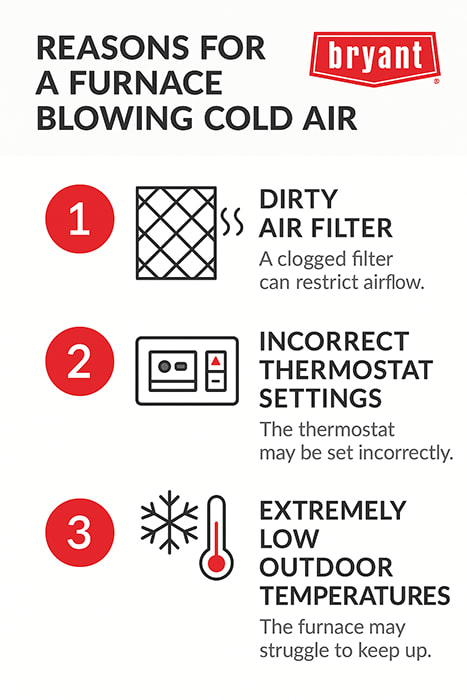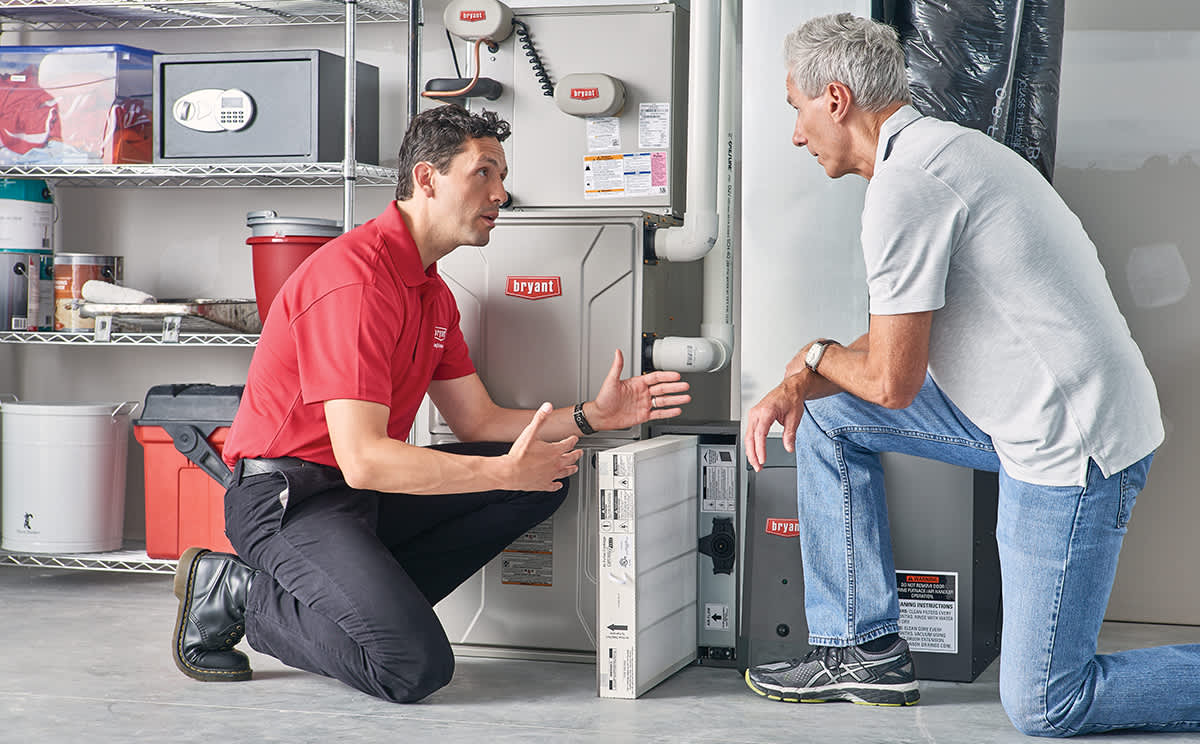About The Author: Travis Baugh is a Digital Brand Marketing Manager for Bryant, where he creates clear, helpful content to guide homeowners through heating, cooling, and indoor air quality decisions. His goal is to empower readers with the knowledge they need to choose the right comfort solutions for their home—confidently and comfortably.
Furnace Blowing Cold Air: Troubleshooting and Solutions
Dealing with a furnace blowing cold air can be particularly aggravating during winter months when warmth is crucial for comfort. Understanding the causes behind this issue is key for effective troubleshooting. This guide delves into the common reasons your furnace might not be heating as expected, along with quick fixes and preventative strategies.
Why Your Furnace is Blowing Cold Air: Common Causes
A furnace blowing cold air can stem from several common issues. Common issues include:
- Dirty air filter: Clogged furnace filters restrict airflow, causing the furnace to overheat and shut off prematurely, resulting in cold air from the vents. Regularly inspecting and replacing filters can prevent this problem.
- Incorrect thermostat settings: Incorrect thermostat settings can also lead to cold air. If your thermostat is set to 'fan' instead of 'auto', the fan runs continuously, circulating air even when the furnace isn’t heating. Adjusting your thermostat to 'auto' ensures optimal heating.
- Extremely low outdoor temperatures: Frigid temperatures can strain your heating system, making it harder to maintain the desired indoor temperature.
- Poor home insulation: Poor insulation can exacerbate this issue by causing heat loss, making it seem like the furnace is malfunctioning. Enhancing insulation and sealing can significantly boost your furnace's efficiency.
Recognizing these common issues allows you to take proactive steps to ensure your furnace operates smoothly, keeping your home cozy during cold months.

Quick Fixes for A Furnace Blowing Cold Air
Melissa Frause, owner of Bob’s Heating and Air Conditioning in Woodinville, WA, recommends homeowners try these quick fixes if your furnace is blowing cold air.
"For gas furnace troubleshooting, we recommend checking that your thermostat is set to heat mode, the furnace has power (checking the breaker, shut-off switch, and fan), the filter is clean, and all vents are open and unobstructed,” Frause said.
Further help with each troubleshooting step incudes:
- Check the air filter. A dirty filter can restrict airflow and hinder your furnace's efficiency. Locate and inspect the air filter; if it's dirty, replace it with a clean one to improve performance and restore warm air flow.
- Reset your thermostat and furnace: Resetting your thermostat and furnace can resolve minor glitches. Turn off the thermostat, wait a minute, then turn it back on. Follow by turning off the furnace for a few minutes before restarting. This simple reset can help clear errors and recalibrate your system.
- Inspect ductwork for blockages or leaks. Even if your furnace functions properly, duct issues can lead to cold air in your home. Check for obstructions, like furniture or debris, and ensure vents are open and unobstructed. If you suspect a duct leak, contacting your local Bryant dealer for furnace inspection and furnace repair is advisable.
- Check your furnace’s pilot light or ignition system. If it's out, the system won't produce heat.
"If all of these have been checked, then it’s time to call your local furnace service professional," Frause said.
When Professional Help is Needed For a Furnace Blowing Cold Air
While furnace troubleshooting can help fix many issues, recognizing when to call a professional is crucial if your furnace is blowing cold air.
A few signs you may need professional help include:
- Unusual noises, such as banging or rattling
- Frequent cycling on and off
- A sudden spike in heating bills may also indicate your furnace is overworking, necessitating professional assessment.
While some issues can be addressed with DIY methods, understanding the limitations of these fixes is important. Tasks like replacing air filters or adjusting thermostat settings can be done independently, but complex issues like electrical problems or gas leaks require professional expertise for safety and reliability.
Preventing A Furnace Blowing Cold Air
To prevent your furnace from blowing cold air, regular furnace maintenance and attention to system settings are key. Start by checking your thermostat—ensure it's set to “heat” and the fan is set to “auto” instead of “on,” which can cause the system to blow air even when it's not heated. Replace your air filter every 1–3 months to maintain proper airflow and avoid overheating shutdowns. It’s also important to inspect vents and registers to ensure they’re open and not blocked by furniture or debris. If your system uses a pilot light or electronic ignition, confirm it’s functioning properly—an extinguished pilot or faulty igniter will prevent heat generation.
Additionally, schedule annual furnace tune-ups with your local Bryant dealer to catch issues like faulty sensors, dirty burners, or failing components before they lead to cold air problems. Preventive care helps ensure reliable performance and keeps your home warm and comfortable during the heating season.
“It’s kind of like a car,” Samantha Houchin, owner of The Weather Changers in Denver, Colorado, said. “You have to get oil changes to help the engine run. It's the same thing with heating and cooling. doing routine maintenance, make sure that the system runs the way that it's supposed to.”
How Long Will It Take To Resume Blowing Warm Air?
If your furnace is blowing cold air, you might wonder how long it takes to resume blowing warm air. Once your furnace is fixed, it typically takes 5 to 15 minutes to resume blowing warm air, depending on the types of furnace and the specific repair. After the unit restarts, the burners or heating elements need a short time to warm up, followed by the blower fan activating to distribute heated air. If it takes significantly longer, there may still be an issue that needs attention.
Connect With A Bryant Professional For Cold Air From Furnace Issues
If your furnace is blowing cold air, connecting with a Bryant dealer is the best step toward restoring consistent, reliable heat. Cold air issues can stem from a variety of causes and Bryant dealers are trained to diagnose these problems quickly and accurately. They’ll inspect your system, identify the root cause, and recommend the best course of action to get your furnace back to optimal performance.
Attempting DIY repairs can often overlook underlying issues or lead to further damage, especially with gas or high-efficiency systems. A certified Bryant technician ensures that any necessary repairs are completed safely and effectively. In addition to fixing the immediate problem, your dealer can also perform a full system check to help prevent future issues. They can even perform a furnace replacement if necessary. Whether it’s a simple fix or a deeper issue, a Bryant dealer will provide trusted support to keep your home warm and comfortable. Schedule an appointment today.
Furnace Blowing Cold Air FAQs
Start by ensuring the thermostat is set to “heat,” the air filter is clean, and the gas supply is on; also check for error codes or flashing lights on the furnace panel.
Yes, it’s normal for a furnace to blow cold air briefly at startup while the blower clears out cool air in the ducts before the burners fully ignite.
Common causes include a dirty filter, faulty thermostat, pilot light or ignition failure, or overheating due to restricted airflow, which can trigger a safety shutdown.
Check the thermostat settings, replace the air filter, and inspect the pilot light or breaker—if those are fine, contact a professional for further diagnosis.
Your furnace may be blowing cold air due to a dirty air filter, thermostat issue, pilot light failure, or a problem with the flame sensor or gas supply.
Your furnace may not turn on due to power issues, a dirty flame sensor, low gas supply, or a safety switch that’s been triggered.
Learn More About Furnaces
- Learn how much is a new furnace
- Explore what is a furnace
- Get help with a furnace not turning on or a furnace leaking water
- Find out how long does a furnace last
- Learn about the importance of furnace cleaning



